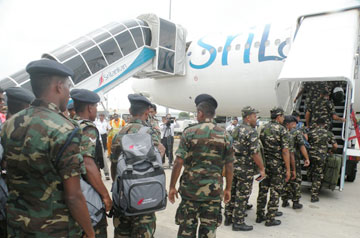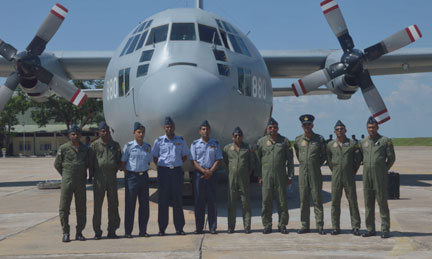Into the rescue...
Sri Lankan emergency rescue and relief operations in
quake-hit Nepal:
by Dhaneshi Yatawara
Villagers were huddled together by the river to keep themselves warm-
a bitter cold wind was blowing. They did not know what to do with
themselves. No food, no shelter and worst of all except for the clothes
they were in- they had nothing to cover themselves to keep away the
biting cold. It seemed like eternity for them. They had no one to turn
to till the good Samaritans -the Sri Lankan military contingent-
arrived.
 |
|
Taking wing to
quake-affected Nepal |
One hundred and forty one military personnel moved 12 to 14
kilometers away from Dolalghat area, to serve the affected people in the
remote villages. The movement of troops was undertaken under the advice
of the Nepalese Army and other ministerial authorities.
Despite freezing weather conditions, the Army, Navy and Air Force men
are living in temporary shelters built on river banks in the land of
mountains. “We have given some of the tents to the sick, old and
children whom we have rescued from these affected villages,” said Major
General Maitri Dias, Officer Commanding of the Sri Lankan military
contingent in Nepal. The Sri Lankan soldiers have given accommodation to
them as their homes, which are just mud houses, were destroyed in the
devastating earthquake. Until the troops reached the village, the people
were sleeping on the river banks – the old, sick and children as well.
Transport to send people to the nearest hospital was difficult. Being
told of the ground situation, Army Commander Chrishanthe de Silva
approved the use of their own financial resources to hire private
vehicles, considering the emergency requirement of victims.
Within 48 hours
The first batch of 44 service personnel went to Kathmandu on an Air
Force flight along with four civil medical consultants who reached
Dolalghat in the early hours of last Sunday. Within 48 hours they
rescued, treated and evacuated nearly 300 earthquake victims in the
area. Villagers in the area the Army contingent was deployed, had only
mud houses and the earthquake destroyed them. Unable to do anything else
they just slept on the river bank. A woman whose spine was completely
damaged as she was buried under rubble for days had to be given
emergency treatment and immediately evacuated.
The Sri Lankan contingent had to walk about 12 kilometers before she
was rescued and subsequently sent to the Kathmandu General Hospital last
Monday (27) afternoon. “Serious injuries were not uncommon among the
victims. There were head injuries, broken bones, spinal cord injuries
and many such cases where our troops had to treat,” he said. Within the
first 24 hours the Sri Lankan team had to treat five seriously injured
victims.
Generosity
Being one of the countries who responded fast to help the earthquake
devastated people of Nepal, Sri Lankans have proved that they were a
generous nation, despite being a developing country. The dedication of
the military personnel proved beyond doubt the selfless devotion they
had within them.
As of today the troops are working in remote villages in Saping and
Palanchit areas. The Engineering and Engineering services troops are
clearing access roads and bridges in the Saping area. “Many of these
bridges are destroyed covered with earth and we do not have machinery to
do the clearing work. The earthquake has destroyed most of it and since
this is a mountainous area machines are of very little use,” said Maj.
Gen. Dias.
 |
|
Air Force personnel-
minutes before boarding the aircraft to Nepal Pix by Airport Cor. |
The Sri Lanka Army and Air Force became the nation’s saviours, when
the load of relief items collected had to be sent to earthquake
devastated Nepal. Armed with several years of rough war- time
experience, the Sri Lanka Air Force confidently took the responsibility
given to them.
Wing Commander, Manjula Krishantha, Sqn. Ldr. Prabash Mahanama with
another Navigating pilot, Sqn. Ldr. Sampath Mallawarachchi along with
the C130 crew of the Sri Lanka Air Force (SLAF) No.2 squadron, were
given orders to take the first consignment of aid to Nepal.
“That Sunday my Commanding Officer (CO) Wing Commander Wasantha
Dahanayake conveyed us the order from Air Force Headquarters to fly to
Kathmandu taking relief items and volunteers,” said one of the pilots,
Sq. Ldr. Mahanama, explaining the start.
They were ordered to take off in two hours. The CO and the pilots
immediately made flight arrangements. After giving all the required
details the flight clearance was given for the designated route. “It was
a five hour journey,” he said.
For the pilots it was the first-ever flight to Kathmandu. They took
off around 5.30 in the morning on Sunday with 7000 kg of relief
assistance comprising medical equipment, medicine, water, dry rations
and variety of essential good from the government as well as goods
donated by Sri Lankans. There were 44 Army personnel – doctors and
soldiers – as well as four civil Medical Consultants.
Landing technique
They were to fly via Chennai, Culcutta to Kathmandu. “Kathmandu
airport is located in a valley and landing techniques were different. We
have never landed in an airport in that kind of terrain,” he said. For
in this type of area, there were nternationa guidelines.
Planes descend step by step without gliding down while landing, which
in aviation is called the ‘ Step bound approach’, explained Sqd. Ldr.
Mahanama.
The Sri Lankan Ambassador in Nepal, W.M. Seneviratne, and Nepal
military top officials were at the Kathmandu Airport to receive the Sri
Lankan team on Sunday morning. Following a brief rest the crew returned
with the 42 rescued Sri Lankans.
Second batch
The second batch of 97 service personnel reached Kathmandu last
Wednesday (29) aboard the Sri Lankan Airlines flight UL 4195 to join
there colleagues to continue the humanitarian work.
The initial decision to take sniffer dogs was shelved as there was no
necessity in Nepal. The second batch was of three officers and 69 other
rankers from the Army, one Officer and 13 other rankers from the Navy
and one officer and 10 other rankers from the Air Force. The Army
contingent comprise of officers and men from the Engineers, Engineer
Service Regiment and Medical Corps.
When the Government took the decision to send military troops to
Nepal, the response from the troops had been immense, according to Brgd.
Jayaweera. Sending troops to help Nepal was taken during an urgent
meeting summoned by President Maithripala Sirisena and Prime Minister,
Ranil Wickremasinghe to discuss what we could do to assist Nepal in this
natural disaster.
The second flight carried 17 tonnes of relief items. The load
included items such as medicine, water purification tablets, warm
clothing, engineering, signal and ordnance equipment, supportive
transport requirements, water bottles, health accessories and dry
rations.
Although relief was pouring in, there were two major constraints
affecting the transfer of the relief items. One was a lack of storage
space to stock the goods and the other was a shortage of Air Force
planes to transport the goods to the quake-hit nation. |

